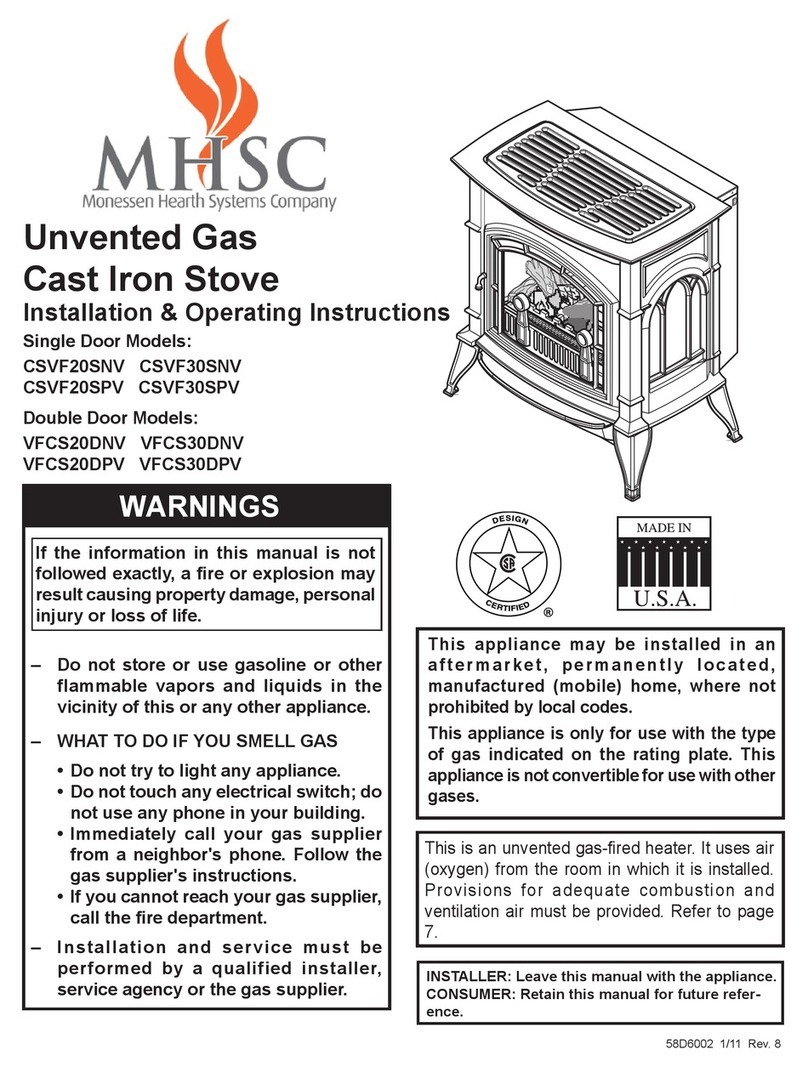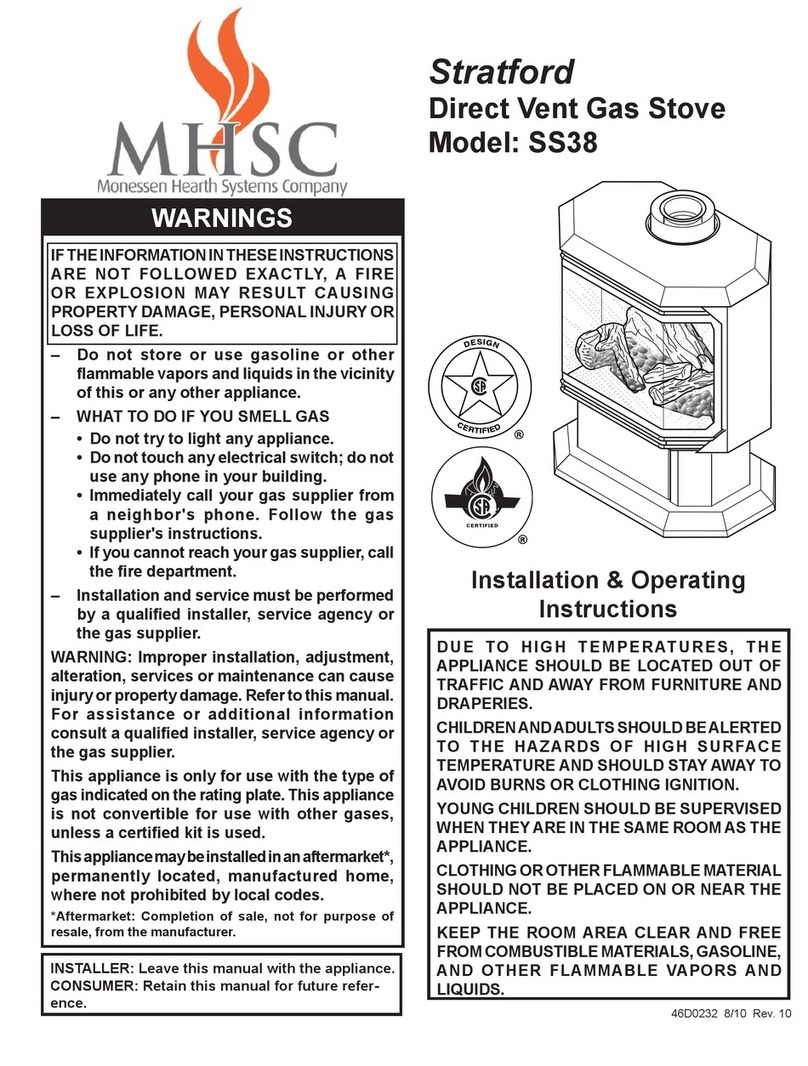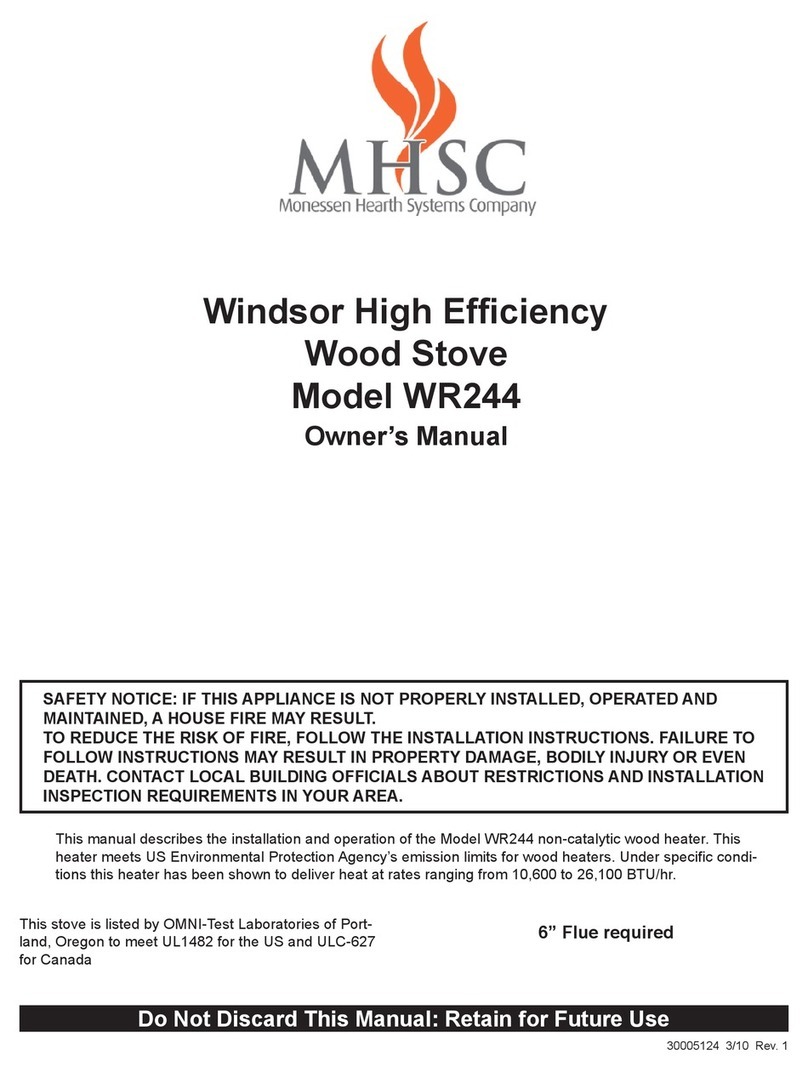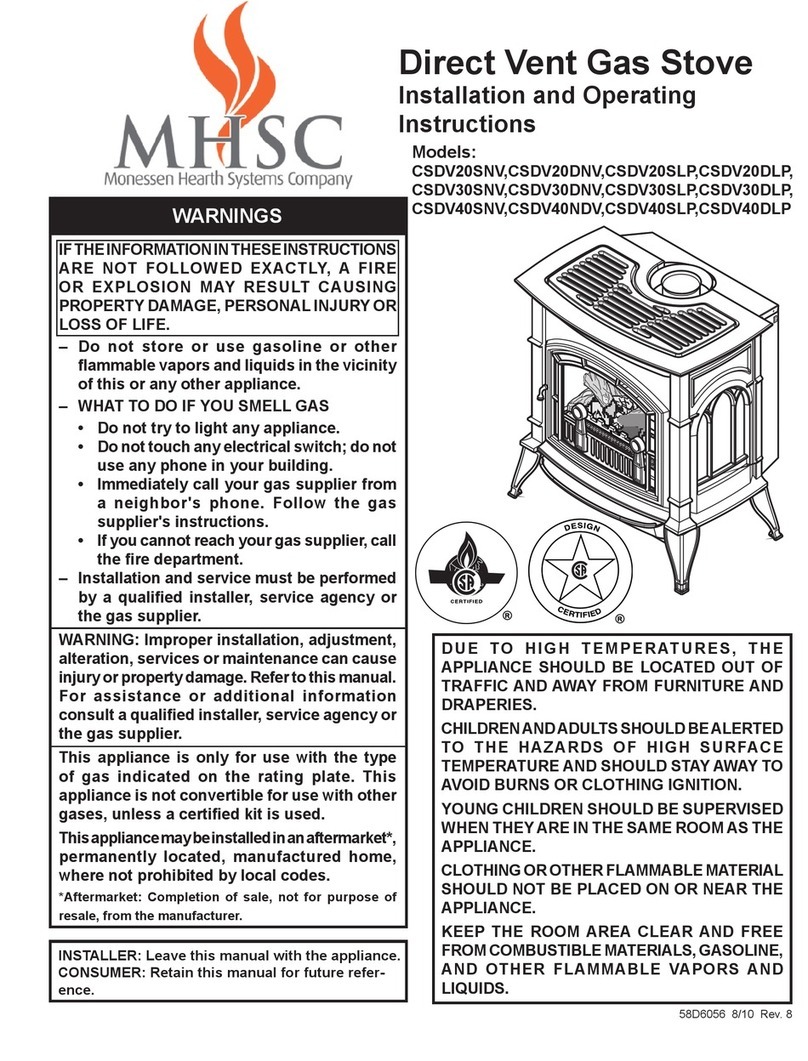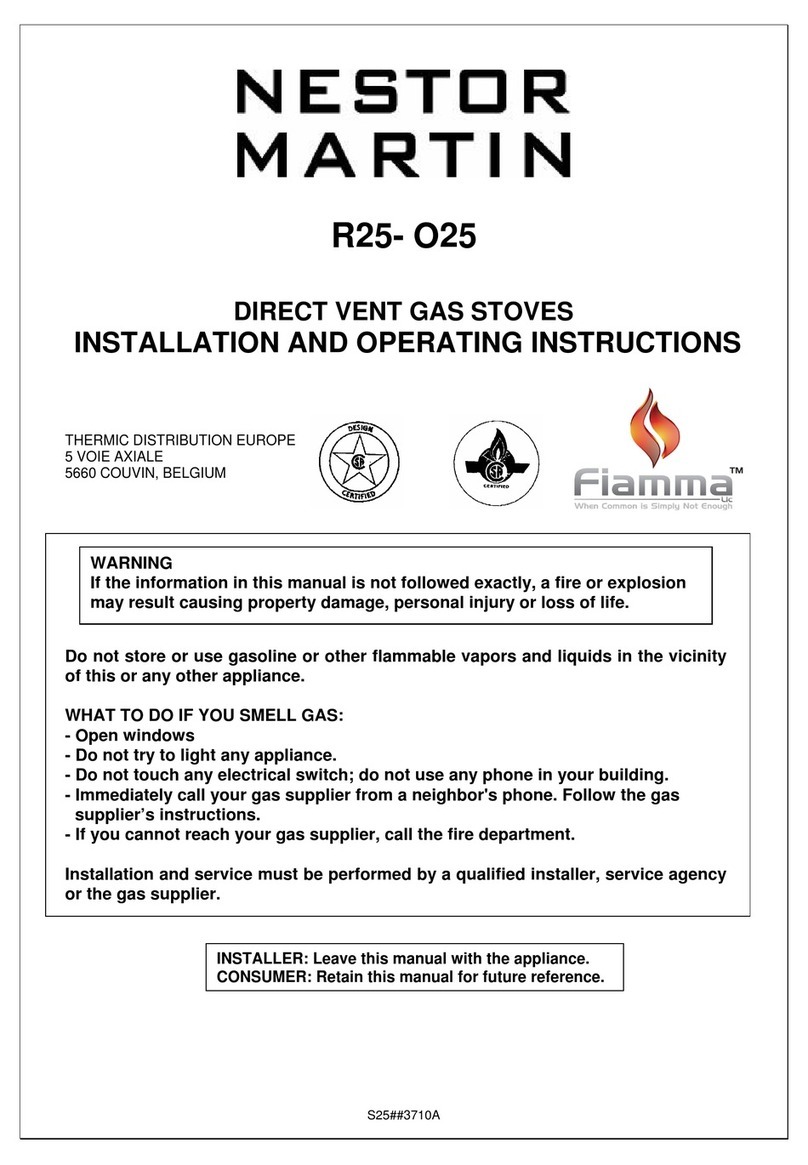MHSC RFSDV24 Assembly instructions

RFSDV_24_34_line
1_3550
rev. 0602 rjs
Installation Instructions and
Homeowner’s Manual
10003550 2/10 Rev. 10
DO NOT STORE
OR USE GASOLINE OR
OTHER FLAMMABLE VAPORS
AND LIQUIDS IN THE VICINITY
OF THIS OR ANY OTHER
APPLIANCE.
WHAT TO DO IF YOU SMELL GAS:
• Do not try to light any appliance.
• Do not touch any electric switch;
do not use any phone in your
building.
• Immediately call your gas
supplier from your neighbor’s
phone. Follow the gas suppliers
instructions.
• If you cannot reach your gas
supplier call the fire department.
WARNING!
IF THE INFORMATION IN THIS
MANUAL IS NOT FOLLOWED
EXACTLY, A FIRE OR
EXPLOSION MAY RESULT
CAUSING PROPERTY
DAMAGE, PERSONAL INJURY
OR LOSS OF LIFE.
PLEASE READ THIS MANUAL
BEFORE INSTALLING AND
USING APPLIANCE
INSTALLER/CONSUMER
SAFETY INFORMATION
FOR YOUR SAFETY
Installation and service must
be performed by a qualified
installer, service agency or
the gas supplier.
Freestanding Direct
Vent Gas Stove
Models:
RFSDV24, RFSDV34
INSTALLER: Leave this manual with the appliance.
CONSUMER: Retain this manual for future reference.

2
RFSDV24/34 Freestanding Direct Vent Gas Stove
10003550
Installation & Operating Instructions
General Information, Warnings, Cautions ...........................................................................3
Requirements for the Commonwealth of Massachusetts ....................................................4
Unit Dimensions ..................................................................................................................5
Locating Your Stove ............................................................................................................6
Clearance to Combustibles .................................................................................................6
High Elevations ...................................................................................................................6
Gas Inlet and Manifold Pressures .......................................................................................6
Gas Specifications ...............................................................................................................6
Preparation ..........................................................................................................................6
Gas Line Installation ............................................................................................................6
Remote Switch Installation .................................................................................................. 7
General Venting Information
General Venting Information-Termination Location ............................................................8
General Information on Assembling Vent Pipes .................................................................. 9
How to Use the Vent Graph...................................... .........................................................10
Vertical Sidewall Applications & Installation ......................................................................10
Below Grade Installations.. ................................................................................................13
Vertical Through-the-Roof Applications & Installations ......................................................14
Venting Components ......................................................................................................... 16
Operating Instructions
Glass Information ..............................................................................................................17
Window Frame Assembly Removal ...................................................................................17
Glass Cleaning .................................................................................................................. 17
Log Set and Lava Rock Material Installation ..................................................................... 17
Flame & Temperature Adjustment .....................................................................................19
Flame Characteristics ........................................................................................................19
Lighting & Operating Instructions ......................................................................................20
Troubleshooting NOVA SIT 820 Millivolt Valve ..................................................................21
Instructions for RCSITE .....................................................................................................22
Troubleshooting ................................................................................................................25
Maintenance
Cleaning the Standing Pilot Control System ..................................................................... 27
Wiring Diagrams ................................................................................................................28
Replacement Parts ......................................................................................................................30
Optional Accessories
Fan Kits ............................................................................................................................. 33
Optional Gold Trim Kit .......................................................................................................34
Optional Brass Trim Kit ......................................................................................................34
Remote Control Units ........................................................................................................ 34
Warranty .......................................................................................................................................35
Energuide ......................................................................................................................................36
PLEASE READ THE INSTALLATION & OPERATING INSTRUCTIONS BEFORE USING THIS APPLIANCE.
Thank you and congratulations on your purchase of an MHSC gas stove.
IMPORTANT: Read all instructions and warnings carefully before starting installation. Failure to follow these
instructions may result in a possible fire hazard and will void the warranty.
Table of Contents

3
RFSDV24/34 Freestanding Direct Vent Gas Stove
10003550
This gas stove should be installed by a qualified installer in
accordance with local building codes and with current CSA-
B149.1 Installation codes for Gas Burning Appliances and
Equipment. If the unit is being installed in a mobile home, the
installation should comply with the current CAN/USA Z240.4
code. For USA Installations follow local codes and/or the
current National Fuel Gas Code. ANSI Z223.1/NFPA 54.
FOR SAFE INSTALLATION AND OPERATION PLEASE NOTE
THE FOLLOWING:
1 . This unit gives off high temperatures and should be located
out of high traffic areas and away from furniture and draper-
ies.
2. Children and adults should be alerted to the hazards of the
high surface temperatures of this unit and should stay away
to avoid burns or ignition of clothing.
3. CAUTION: Due to high glass surface temperature chil-
dren should be carefully supervised when in the same
room as unit.
Installation & Operating Instructions
This appliance may be installed in an aftermarket
permanently located, manufactured home or mobile
home, where not prohibited by local codes.
This appliance is only for use with the type of gas
indicated on the rating plate. This appliance is not
convertible for use with other gases, unless a certified
kit is used.
Model RFSDV34RMH can be installed in manufactured
(mobile) homes by OEM.
IMPORTANT:
PLEASE REVIEW THE FOLLOWING CAREFULLY
Remove any plastic from from parts before turning the
unit ON.
It is normal for stoves fabricated of steel to give off some
expansion and/or contraction noises during the start up
or cool down cycle. Similar noises are found with your
furnace heat exchanger or car engine.
It is not unusual for your gas stove to give off some odor
the first time it is burned. This is due to the curing of the
paint and any undetected oil from the manufacturing
process.
Please ensure that your room is well ventilated-open
all windows.
It is recommended that you burn your stove for at least
ten (10) hours the first time you use it. If the optional fan
kit has been installed, place the fan switch in the “OFF”
position during this time.
Proposition 65 Warning: Fuels used in gas, woodburn-
ing or oil fired appliances, and the products of combustion
of such fuels, contain chemicals known to the State of
California to cause cancer, birth defects and other repro-
ductive harm.
California Health & Safety Code Sec. 25249.6
RFSDV24 / RFSDV34
Certified To
ANSI Z21.88-2005 / CSA 2.33-2005
Vented Gas Stove Heaters
WARNING
!
HOT GLASS WILL
CAUSE BURNS.
DO NOT TOUCH GLASS
UNTIL COOLED.
NEVER ALLOW CHILDREN
TO TOUCH GLASS.
4. Under no circumstances should this unit be modified. Parts
removed for servicing should be replaced prior to operating
this unit again.
5. Installation and any repairs to this unit must be performed by
a qualified installer, service agency or gas supplier. A profes-
sional service person should be contacted to inspect the unit
annually. More frequent cleaning may be required due to
excess lint and dust from carpeting, bedding material, etc.
6. Control compartments, burners and air passages in this unit
should be kept clean and free of dust and lint. Make sure
that the gas valve and pilot light are turned off before you
attempt to clean this unit.
7. The venting system (chimney) of this unit should be checked
at least once a year and if needed your venting system
should be cleaned.
8. Keep the area around your unit clear of combustible materi-
als, gasoline and other flammable vapour and liquids. This
unit should not be used as a drying rack for clothing, nor
should Christmas stockings or decorations be hung on or
around the unit.
9. Under no circumstances should any solid fuels (wood, coal,
paper or cardboard etc.) be used in this unit.
10. The flow of combustion and ventilation air must not be ob-
structed in any way.
11. When the unit is installed directly on carpeting, vinyl tile or
any combustible material other than wood, this unit must be
installed on a metal or wood panel extending the full width
and depth of the unit.
12. This unit requires adequate ventilation and combustion air to
operate properly.
13. This unit must not be connected to a chimney flue serving a
separate solid fuel burning unit.
14. When the unit is not in use it is recommended that the gas
control valve be left in the OFF position.

4
RFSDV24/34 Freestanding Direct Vent Gas Stove
10003550
Installation & Operating Instructions
Requirements for the Commonwealth of
Massachusetts
All gas fitting and installation of this heater shall only be
done by a licensed gas fitter or licensed plumber.
For all side wall horizontally vented gas fueled
equipment installed in every dwelling, building or
structure used in whole or in part for residential
purposes, including those owned or operated by the
Commonwealth and where the side wall exhaust vent
termination is less than seven (7) feet above finished
grade in the area of the venting, including but not limited
to decks and porches, the following requirements shall
be satisfied:
Installation of Carbon Monoxide Detectors
At the time of installation of the side wall horizontal
vented gas fueled equipment, the installing plumber
or gas fitter shall observe that a hard wired carbon
monoxide detector with an alarm is installed on each
additional level of the dwelling, building or structure
served by the side wall horizontally vented gas fueled
equipment. It shall be the responsibility of the property
owner to secure the services of qualified licensed
professionals for the installation of hard wired carbon
monoxide detectors.
In the event that the side wall horizontally vented gas
fueled equipment is installed in a crawl space or an
attic, the hard wired carbon monoxide detector with
alarm and battery back-up may be installed on the next
adjacent floor level.
In the event that the requirements of this subdivision
can not be met at the time of completion of installation,
the owner shall have a period of thirty (30) days
to comply with the above requirements; provided,
however, that during said thirty (30) day period, a
battery operated carbon monoxide detector with an
alarm shall be installed.
Approved Carbon Monoxide Detectors
Each carbon monoxide detector as required in
accordance with the above provisions shall comply with
NFPA 720 and ANSI/UL 2034 listed and IAS certified.
Signage
A metal or plastic identification plate shall be
permanently mounted to the exterior of the building at
a minimum height of eight (8) feet above grade directly
in line with the exhaust vent terminal for the horizontally
vented gas fueled heating appliance or equipment. The
sign shall read, in print size no less than one-half (1/2)
inch in size, “GAS VENT DIRECTLY BELOW, KEEP
CLEAR OF ALL OBSTRUCTIONS”.
Inspection
The state or local gas inspector of the side wall
horizontally vented gas fueled equipment shall not
approve the installation unless, upon inspection, the
inspector observes carbon monoxide detectors and
signage installed in accordance with the provisions of
248 CMR 5.08(2)(a)1 through 4.
Exemptions
The following equipment is exempt from 248 CMR
5.08(2)(a)1 through 4:
• The equipment listed in Chapter 10 entitled
“Equipment Not Required To Be Vented” in the most
current edition of NFPA 54 as adopted by the Board;
and
• Product Approved side wall horizontally vented gas
fueled equipment installed in a room or structure
separate from the dwelling, building or structure
used in whole or in part for residential purposes.
MANUFACTURER REQUIREMENTS
Gas Equipment Venting System Provided
When the manufacturer of Product Approved side
wall horizontally vented gas equipment provides a
venting system design or venting system components
with the equipment, the instructions provided by the
manufacturer for installation of the equipment and the
venting system shall include:
• Detailed instructions for the installation of the venting
system design or the venting system components;
and
• A complete parts list for the venting system design or
venting system.
Gas Equipment Venting System NOT Provided
When the manufacturer of a Product Approved side
wall horizontally vented gas fueled equipment does
not provide the parts for venting the flue gases, but
identifies “special venting systems”, the following
requirements shall be satisfied by the manufacturer:
• The referenced “special venting system” instructions
shall be included with the appliance or equipment
installation instructions; and
• The “special venting systems” shall be Product
Approved by the Board, and the instructions for
that system shall include a parts list and detailed
installation instructions.
A copy of all installation instructions for all Product
Approved side wall horizontally vented gas fueled
equipment, all venting instructions, all parts lists
for venting instructions, and/or all venting design
instructions shall remain with the appliance or
equipment at the completion of the installation.

5
RFSDV24/34 Freestanding Direct Vent Gas Stove
10003550
Stove Dimensions
Fig. 1 Stove specifications and framing dimensions.
A
D
I
H
B
K
J
G
F
E
C
3550
RFSDV34 dims
Ref. RFSDV24 RFSDV34
A 23” (584 mm) 26Z\v” (667 mm)
B 28C\v” (730 mm) 31Z\x” (800 mm)
C 16B\,” (422 mm) 19C\,” (492 mm)
D 27C\,” (695 mm) 30” (762 mm)
E 9Z\x” (241 mm) 10” (254 mm)
F 13M\,” (352 mm) 15Z\x” (394 mm)
G 4” (102 mm) 4Z\x” (114 mm)
H 23” (584 mm) 26Z\v” (667 mm)
I 11Z\x” (292 mm) 13Z\,” (333 mm)
J 16B\,” (422 mm) 19Z\x” (495 mm)
K 6” (152 mm) 6C\,” (162 mm)

6
RFSDV24/34 Freestanding Direct Vent Gas Stove
10003550
12” (305 mm)
A
12”
(305 mm)
B
E
C
D
FP1620
locate freestanding
Top of Unit to Ceiling ............................... 36” (914 mm)
Appliance
Back ........................................................ 0” (0 mm)
Side ................................................... 12” (305 mm)
Floor ........................................................ 0” (0 mm)
Corner ............................. 0” (0 mm) to Back Edges
Vent Pipe ............................................... 1” (25 mm)
Clearance to Combustibles
High Elevations
Input ratings are shown in BTU per hour and are
certified without deration for elevations up to
4,500 feet (1,370 m) above sea level.
For elevations above 4,500 feet (1,370 m) in USA,
installations must be in accordance with the cur-
rent ANSI Z223.1/NFPA 54 and/or local codes hav-
ing jurisdiction.
In Canada, please consult provincial and/or local
authorities having jurisdiction for installations at
elevations above 4,500 feet (1,370 m).
Natural LP (Propane)
Inlet Minimum 5.5” w.c. 11.0” w.c.
Inlet Maximum 14.0” w.c. 14.0” w.c.
Manifold Pressure 3.5” w.c. 10.0” w.c.
Gas Inlet and Manifold Pressures
Preparation
The use of wallpaper adjacent to this stove is not rec-
ommended, as the high heat given off by this stove may
adversely affect the binders in the adhesive used to
apply the wallpaper.
Before beginning, remove the window frame assembly
from the stove. Also check to make sure there is not
hidden damage to the stove. Take a minute and plan
out the gas, vent and electrical supply. Refer to Window
Frame Assembly Removal Section.
A) Flat on wall* B) Room Divider* C) Island
D) Cross Corner E) Flat on wall corner
Note (Fig. 2): *(A) and (B) must maintain a 12” (305 mm)
clearance between the wall and side glass of stove.
Locating Your Stove
Fig. 2 Locate gas stove.
FP1620
There is a minimum vertical rise required
for the venting, which varies depending on
the application. The maximum horizontal
run also has restrictions. Before starting
the installation, become familiar with vent-
ing instructions starting on Page 9.
Gas Specifications
Max. Min.
Input Input
Model Fuel Gas Control BTU/h BTU/h
RFSDV24SRN Nat Millivolt Manual 20,000 14,000
RFSDV24SRP Prop Millivolt Manual 20,000 15,000
RFSDV34TSRN Nat Millivolt Hi/Lo 30,000 21,000
RFSDV34TSRP Prop Millivolt Hi/Lo 30,000 22,500
Gas Line Installation
When purging gas line, the front window
frame assembly must be removed.
The gas pipeline can be brought in through the rear of
the stove as well as the bottom. Knockouts are provided
on the bottom behind the valve to allow for the gas pipe
installation and testing of any gas connection. It is most
convenient to bring the gas line in from the rear right
side of the valve as this allows fan installation or remov-
al without disconnecting the gas line.
The gas line connection can be made with properly
tinned 3/8” copper tubing, 3/8” rigid pipe or an ap-
proved flex connector. Since some municipalities have
additional local codes, it is always best to consult your
local authority and the National Fuel Gas Code, ANSI
Z223.1/NFPA 54 in the USA or the CSA-B149.1 installa-
tion codes.
Always check for gas leaks with a mild
soap and water solution. Do not use an
open flame for leak testing.
The gas control is equipped with a captured screw type
pressure test point, therefore it is not necessary to pro-
vide a 1/8” test point up stream of the control.
When using copper or flex connector use only approved
fittings. Always provide a union when using black iron
pipe so that the gas line can be easily disconnected for
burner or fan servicing . See gas specifications for pres-
sure details and ratings.
The stove valve must not be subjected to any test pres-
sures exceeding 1/2 psi. Isolate or disconnect this or
any other gas appliance control from the gas line when
pressure testing.

7
RFSDV24/34 Freestanding Direct Vent Gas Stove
10003550
CFM106
Typical Gas Line Connection
9-29-00
1/2” Gas Supply
1/2” x 3/8” Reducer
3/8” Nipple
3/8” x 3/8”
Shut-Off Valve
3/8” Nipple
3/8” Union
3/8” Nipple
CFM106
Fig. 3 Typical gas line connection.
Installation of Remote Switch
for RSN/RSP Gas Valve
NOTES: The remote ON/OFF switch cannot be fit-
ted to units using the Honeywell Radio Frequency
control valve.
If the stove has been fitted with the RCSITEA Con-
trol, the ON/OFF function is controlled by the re-
mote handset or receiver switch. Refer to Page 22.
Install the ON/OFF switch assembly on either the rear
right or rear left side of the stove.
1. Remove the screw at the back of the cabinet top
either on the left or the right side of the stove.
2. Position switch assembly onto the back of the stove,
then fasten two (2) screws as shown in Figure 3.
3. Attach wiring under the clips on the rear casing (Fig.
4) and install wiring through the rear opening of the
stove before connecting to the valve as shown in
Figure 5.
&02&3$6SWITCH
ON/OFF Switch
Assembly
Clips
Screw
Screw
(through existing
hole)
Wiring for
Millivolt Gas
Valves
FP1621
Fig. 4 Attach wiring under clips on rear casing.
P
I
L
O
T
TPTH TP TH
&0
3)4VALVEWSWITCH
Valve
Thermopile
FP1622
ON/OFF Switch or
Millivolt Thermostat
SIT Valve
Fig. 5 Install wiring to switch before connecting to valve.

8
RFSDV24/34 Freestanding Direct Vent Gas Stove
10003550
V
V
V
V
V
V
V
X
X
X
D
E
B
B
B
C
B M
B
A
J
K
F
L
VENT TERMINATION AIR SUPPLY INLET AREA WHERE TERMINAL IS NOT PERMITTED
H
I
Fixed
Closed
Operable
Operable Fixed
Closed
V
B
CFM145a
DV Termin Location
5/01/01 Rev. 12/05/01
sta
INSIDE
CORNER DETAIL
V
A
G
N
CFM145a
General Venting Information - Termination Location
A = Clearance above grade, veranda, porch, 12” (30cm) 12” (30cm)
deck, or balcony
B = Clearance to window or door that may be 6” (15cm) for appliances 6” (15cm) for appliances
opened < 10,000Btuh (3kW), 12” (30cm) < 10,000 Btuh (3kW), 9”
for appliances > 10,000 Btuh (3kW) and (23cm) for appliances > 10,000
< 100,000 Btuh (30kW), 36” (91cm) Btuh (3kW) and < 50,000 Btuh
for appliances > 100,000 Btuh (30kW) (15kW), 12” (30cm) for
appliances > 50,000 Btuh (15kW)
C = Clearance to permanently closed window 12” (305mm) recommended to 12” (305mm) recommended to
prevent window condensation prevent window condensation
D = Vertical clearance to ventilated soffit located
above the terminal within a horizontal 18” (458mm) 18” (458mm)
distance of 2’ (610mm) from the center
line of the terminal
E = Clearance to unventilated soffit 12” (305mm) 12” (305mm)
F = Clearance to outside corner see next page see next page
G = Clearance to inside corner (see next page) see next page see next page
H = Clearance to each inside of center line 3’ (91cm) within a height of 15’ (5m) 3’ (91cm) within a height of 15’
extended above meter/regulator assembly above the meter/regulator assembly (5m) above the meter/regulator
assy
I = Clearance to service regulator vent outlet 3’ (91cm) 3’ (91cm)
J = Clearance to nonmechanical air supply inlet 6” (15cm) for appliances < 10,000 6” (15cm) for appliances
to building or the combustion air inlet to any Btuh (3kW), 12” (30cm) for < 10,000 Btuh (3kW), 9”
other appliances appliances > 10,000 Btuh (3kW) and (23cm) for appliances > 10,000
< 100,000 Btuh (30kW), 36” (91cm) Btuh (3kW) and < 50,000 Btuh
for appliances > 100,000 Btuh (30kW) (15kW), 12” (30cm) for
appliances > 50,000 Btuh (15kW)
K = Clearance to a mechanical air supply inlet 6’ (1.83m) 3’ (91cm) above if within 10
feet (3m) horizontally
L = Clearance above paved sidewalk or paved 7’ (2.13m)† 7’ (2.13m)†
driveway located on public property
M = Clearance under veranda, porch, deck or 12” (30cm)* 12” (30cm)*
balcony
N = Clearance to any other obstruction within a horizontal distance of 18” (450mm).
1 In accordance with the current CSA-B149 Installation Codes
2 In accordance with the current ANSI Z223.1/NFPA 54 National Fuel Gas Codes
† A vent shall not terminate directly above a sidewalk or paved driveway which is located between two single family dwellings and
serves both dwellings
* only permitted if veranda, porch, deck or balcony is fully open on a minimum 2 sides beneath the floor:
NOTE: 1. Local codes or regulations may require different clearances.
2. The special venting system used on Direct Vent Stoves are certified as part of the appliance, with clearances tested and
approved by the listing agency.
3. MHSC assumes no responsibility for the improper performance of the appliance when the venting system does not
meet these requirements.
Canadian Installations1 US Installations2
Fig. 6 Termination location requirements.

9
RFSDV24/34 Freestanding Direct Vent Gas Stove
10003550
General Information on Assembling Vent Pipes
Canadian Installations:
The venting system must be installed in accordance
with the current CSA-B149 .1 installation code.
USA Installations:
The venting system must conform with local codes and/
or the current National Fuel Gas code ANSI Z223.1/
NFPA 54.
Only venting components manufactured by MHSC can
be used in Direct Vent systems.
Twist Lock Pipes
When using MHSC twist-lock pipe it is not necessary to
use sealant on the joints. The only areas of the venting
system that need to be sealed with high temperature
silicone sealant are the collars on the stove and termi-
nation, and the sliding joint of any telescopic vent sec-
tion used in the system.
Fig. 6a Termination clearances.
To join the twist lock pipes together, simply align the
beads of the male end with the grooves of the female
end, then while bringing the ends together, twist the
pipe until the flange on the female end contacts the
external flange on the male end. It is recommended that
you secure the joints with three (3) sheet metal screws,
however this is not mandatory with twist lock pipe.
To make it easier to assemble the joints we suggest
putting a lubricant (Vaseline or similar) on the male end
of the twist lock pipe prior to assembly.
TWL100
Twist Lock Pipe
3/12/99 djt
Male End Female End
Screw Holes TWL100
Fig. 7 Twist-lock pipe joints.
Outside Corner
Inside Corner
Termination Clearances
Termination clearances for buildings with combustible and noncombustible exteriors.
G =
Combustible
6" (152 mm)
Noncombustible
2" (51 mm)
F =
Combustible
6" (152 mm)
Noncombustible
2" (51 mm)
G
Balcony -
with no side wall
M =
Combustible &
Noncombustible
12" (305 mm)
M
Balcony -
with perpendicular side wall
M = 24" (610 mm)
P = 20” (508 mm)
M
F
Alcove Applications*
C
D
C
E
V
V
Combustible &
Noncombustible
V
V
V
E= Min. 6” (152 mm) for
non-vinyl sidewalls
Min. 12” (305 mm) for
vinyl sidewalls
O= 8’ (2.4 m) Min.
O
P
584-15
No.
of Caps DMin. CMax.
1 3’ (.9 mm) 2 x DActual
2 6’ (1.8 m) 1 x DActual
3 9’ (2.7 m) 2/3 x DActual
4 12’ (3.7 m) 1/2 x DActual
DMin. = # of Termination caps x 3
CMax. = (2 / # termination caps) x DActual
*NOTE: Termination in an alcove space (spaces open only on one side and with an overhang) is permitted with the dimensions
specified for vinyl or non-vinyl siding and soffits. 1. There must be a 3’ (914 mm) minimum between termination caps. 2. All
mechanical air intakes within 10’ (1 m) of a termination cap must be a minimum of 3’ (914 mm) below the termination cap. 3. All
gravity air intakes within 3’ (914 mm) of a termination cap must be a minimum of 1’ (305 mm) below the termination cap.

10
RFSDV24/34 Freestanding Direct Vent Gas Stove
10003550
• If a 90° elbow is used in the horizontal vent run
(level height maintained) the maximum horizontal
vent length is reduced by 36” (914 mm). (Fig. 10)
This does not apply if the 90° elbows are used to
increase or redirect a vertical rise. (Fig. 11)
Since it is very important that the vent-
ing system maintain its balance between
the combustion air intake and the flue
gas exhaust, certain limitations as to vent
configurations apply and must be strictly
adhered to.
The vent graph showing the relationship between verti-
cal and horizontal side wall venting will help to deter-
mine the various dimensions allowable.
Minimum clearance between vent pipes
and combustible materials is one 1”
(25mm) on top, bottom and sides unless
otherwise noted.
When the vent termination exits through foundations
less than 20” (508 mm) below siding outcrop, the vent
pipe must flush up with the siding.
It is always best to locate the stove in such a way that
minimizes the number of offsets and horizontal vent
length of vent pipe from the flue collar of the stove to
the face of the outer wall.
Horizontal plane means no vertical rise exists on this
portion of the vent assembly.
• The maximum number of 90° elbows per side wall
installations is three (3).
• For RFSDV24 and RFSDV34 models, the maximum
horizontal rn for a minimum 12” (305 mm) vertical
rise is 3’ (914 mm). (Fig. 9)
Vertical Sidewall Applications
How to Use the Vent Graph
The vent chart should be read in conjunction with the
following vent installation instructions to determine the
relationship of the vertical and horizontal dimensions of
the vent system.
1. Determine the height of the center of the horizon-
tal vent pipe exiting through the outer wall. Using
this dimension on the Sidewall Vent Graph (Fig. 8),
locate the point intersecting with the slanted graph
line.
2. From the point of this intersection, draw a vertical
line to the bottom of the graph.
3. Select the indicated dimension, and position the
stove in accordance with same.
Example A:
If the vertical dimension from the floor of the unit is 11’
(3.4m) the horizontal run to the face of the outer wall
must not exceed 14’ (4.3 m).
Example B:
If the vertical dimension from the floor of the unit is 7’
(2.14m), the horizontal run to the face of the outer wall
must not exceed 8Z\x’ (2.6 m).
Horizontal dimension from the outside face of the wall to
the center of the stove vent flange
Sidewall vent graph showing the relationship between vertical
and horizontal dimensions for a Direct Vent flue system.
Vertical dimension from the floor of the stove to
the center of the horizontal vent pipe
3
4
5
6
7
8
9
10
11
12
13
14
15
16
17
18
19
20
21
22
23
24
25
26
27
28
29
30
3 4 5 6 7 8 9 10 11 12 13 14 15 16 17 18 19 20
Example: A
Example: B
CFM102
DV Graphic
9/28/00 sta
Fig. 8 Sidewall venting graph. (Dimensions in feet)
36”
(914 mm)
x
rev 06-02 rjs
RFSDV24
RFSDV34
x = 12” (305 mm)
FP1495
Fig. 9 Maximum horizontal run.

11
RFSDV24/34 Freestanding Direct Vent Gas Stove
10003550
Example: According to the chart the maximum
horizontal vent length is 20’ (6 m). However, if a
90° elbow is used in the horizontal vent, maximum
horizontal vent length is reduced to 17’ (5.2 m).
In Figure 9, the total of Dim. A and Dim. B must not
exceed 17’ (5.2 m).
• The maximum number of 45° elbows permitted per
installation is six (6). These elbows can be installed
in either the vertical or horizontal run.
• For each 45° elbow installed in the horizontal run,
the length of the horizontal run MUST be reduced by
18” (457 mm). This does not apply if the 45° elbows
are installed on the vertical part of the vent system.
• The maximum number of elbow degrees in a system
is 270°. (Fig. 12)
Example:
Elbow 1 = 90°
Elbow 2 = 45°
Elbow 3 = 45°
Elbow 4 = 90°
Total angular variation = 270°
1 + 2 + 3 + 4 = 270°
FP1239
Fig. 12 Maximum elbow usage.
STEP 1
Locate vent opening on the wall. It may be necessary
to first position the stove and measure to obtain hole
location. Depending on whether the wall is combustible
or noncombustible, cut opening to size. (Fig. 13)
For combustible walls first frame in opening.
Combustible Walls: (Fig. 13) Cut a 9C\,”H x 9C\,”W (240
x 240 mm) hole through the exterior wall and frame as
shown.
Noncombustible Walls: (Fig. 13) Hole opening must
be 7Z\x” (190 mm) in diameter.
Vertical Sidewall Installations
VO584-100
Vent Opening
2/99 djt
Vent Opening for Combustible Wall
9C\,”
(240mm)
9C\,”
(240mm)
Stove Hearth
Framing
Detail
Opening for Noncombustible Wall
7Z\x”
(190mm)
VO584-100
Fig. 13 Locate vent opening on wall.
7.5ʼ
(2286 mm)
FSDV 2 elbow 20 appl.
rev 0602 rjs
A + B =17’ (5.2 m) Max.
FP1496
Fig. 10 90° elbow used in horizontal vent run.
20ʼ
(6 m)
7.5ʼ (2. m)
rev 0602 rjs
Pipe Straps
Every 3’ (914 mm)
Pipe Straps Every 3’
(914 mm) Firestop / Zero
Clearance Sleeve
FP1497
Fig. 11 90° elbow used to increase height.

12
RFSDV24/34 Freestanding Direct Vent Gas Stove
10003550
STEP 2
Measure wall thickness and cut zero clearance sleeve
parts to proper length (MAXIMUM 12”/305 mm). As-
semble sleeve and attach to firestop with #8 sheet
metal screws (supplied). Install firestop assembly. (Fig.
14)
Zero clearance sleeve is only required for
combustible walls.
X
&0
HTTOCENTER
FP1508
Fig. 15 Height to center of wall opening.
ZCS101
Zero Clearance Sleeve
3/11/99 djt
Max. Length
12” (305 mm)
#8 Screws (2)
#8 Screws
(2)
Adjustable
Zero Clearance
Sleeve
#8 Screws
(2)
Adjustable Zero Clearance Sleeve ZCS101
Fig. 14 Adjustable zero clearance sleeve.
Firestop
STEP 3
Place stove into position. (Fig. 15) Measure the vertical
height (X) required from the base of the flue collars to
the center of the wall opening.
STEP 4
Apply a bead of high temperature sealant to the inner
and outer flue collars of the stove and using appropri-
ate venting component(s) attach to stove with three (3)
screws. (Fig. 16) Follow with the installation of the inner
and outer elbow. Again secure joints as described on
Page 8.
FSDV Step 4b
8-26-02 rjs
FP1509
Bead of Sealant
Fig. 16 Horizontal vent length.
STEP 5
Measure the horizontal length requirement including
a 2” (51 mm) overlap, ie from the elbow to the outside
wall face plus 2” (51 mm) (or the distance required if
installing a second 90° elbow). (Fig. 17)
Always install horizontal venting on a level
plane.
X
FP1510
Fig. 17 Horizontal length to wall.
STEP 6
NOTE: If using charcoal wall plate Pt. #10000257,
and collar Pt. # 52203-CG, put them in place before
putting the pipe sections through the wall.
Use appropriate length of pipe sections - telescopic or
fixed - and install the horizontal vent sections. The sec-
tions which go through the wall are packaged with the
starter kit, and can be cut to suit if necessary. (Fig. 18)
Sealing vent pipe and firestop gaps with
high temperature sealant will restrict cold
air being drawn in around stove.

13
RFSDV24/34 Freestanding Direct Vent Gas Stove
10003550
FP1511
Fig. 18 Pipe sections through the wall.
STEP 7
Apply high temperature sealant to 4” (102 mm) and
7” (179 mm) collars or the termination one inch away
from crimped end. Guide the vent terminations 4” and
7” collars into their respective vent pipes. Double check
that the vent pipes overlap the collars by 2” (51 mm).
Secure the termination to the wall with screws provided
and caulk around the wall plate to weatherproof. (Fig.
19)
FP1512
Fig. 19 Horizontal length to wall.
Support horizontal pipes every 3’ (914 mm)
with metal pipe straps.
Check stove to make sure it is leveled and
properly positioned.
Below Grade Installations
When it is not possible to meet the required vent ter-
minal clearances of 12” (305 mm) above grade level a
snorkel vent kit is recommended. It allows installation
depth of down to 7” (178 mm) below grade level. The
7” is measured from the center of the horizontal vent
pipe as it penetrates through the wall.
If venting system is installed below
ground, we recommend a window well with
adequate and proper drainage.
Ensure sidewall venting clearances are
observed.
If installing a snorkel, a minimum 24” (610 mm) vertical
rise is necessary. The maximum horizontal run with
the 24” (610 mm) vertical pipe is 36” (914 mm). This
measurement is taken from the collar of the stove (or
transition elbow) to the face of the exterior wall. Refer to
the Sidewall Vent Graph for extended horizontal run if
the vertical rise exceeds 24” (610 mm).
1. Establish vent hole through the wall. (Fig. 13)
2. Remove soil to a depth of approximately 16”
(406 mm) below base of snorkel. Install drain pipe.
Install window well (not supplied). Refill hole with 12”
(305 mm) of coarse gravel leaving a clearance of
approximately 4” (102 mm) below snorkel. (Fig. 20)
3. Install vent system.
4. Ensure a watertight seal is made around the vent
pipe coming through the wall.
5. Apply high temperature sealant caulking (supplied)
around the 4” and 7“ snorkel collars.
6. Slide the snorkel into the vent pipes and secure to
the wall.
7. Level the soil to maintain a 4” (102 mm) clearance
below snorkel. (Fig. 20)
24”
(610 mm)
Min.*
Firestop
7” Pipe
7TDVSNORK
(Snorkel)
4” (102 mm)
Clearance
Min.
Window
Well
Drain
Fig. 20 Below grade installation.
*A minimum of 24” (610 mm)
vertical pipe must be installed
when using the 7TDVSNORK
Kit.
*The 22” (559 mm) vertical rise
(center to center) of the snorkel
may be included for calculationof
max. horizontal run.
Screws
Foundation Wall
FP1513

14
RFSDV24/34 Freestanding Direct Vent Gas Stove
10003550
If the foundation is recessed, use recess brackets (not
supplied) for securing lower portion of the snorkel.
Fasten brackets to wall first, then secure to snorkel
with self drilling #8 x 1/2 sheet metal screws. It will be
necessary to extend vent pipes out as far as protruding
wall face. (Fig. 21)
Do not back fill around snorkel. A clear-
ance of at least 4” (102 mm) must be main-
tained between snorkel and the soil.
BG401
Snorkel
2/10/99 djt
Snorkel
Wall Screws
Foundation Recess
Recess Brackets
Watertight Seal
Around Pipe
Sheet Metal
Screws
BG401
Fig. 21 Snorkel installation, recessed foundation.
Vertical Through-the-Roof Applications
This Gas Stove has been approved for:
• Vertical installations up to 40’ (12 m) in height. Up
to a 10’ (3 m) horizontal vent run can be installed
within the vent system using a maximum of two 90°
elbows.
• Up to two 45° elbows may be used within the
horizontal run. For each 45° elbow used on the
horizontal level the maximum horizontal length must
be reduced by 18” (457 mm).
Example: Maximum horizontal length
0 x 45° elbows = 10’ (3 m)
1 x 45° elbows = 8Z\x’ (2.6 m)
2 x 45° elbows = 7’ (2.1 m)
• A minimum of an 8’ (2.4 m) vertical rise.
• Two sets of 45° elbows offsets within these vertical
installations. From 0 to a maximum of 8’ (2.4 m) of
vent pipe can be used between elbows. (Fig. 22)
• 7DVCS must be used to support offsets. (Fig. 22)
This application will require that you first determine
the roof pitch and use the appropriate starter kit.
(Refer to Venting Components List)
CFM140
Typical vertical through-the-roof application
2/01 sta;
rev. 0602 rjs
Max.
8’
(2.4 m)
45°
Max.
8’
(2.4 m)
45°
Max. 40’
(12 m)
Typical Straight-up Installation
Typical
Ceiling
Support
Application
Typical
Roof Support
Application
CFM140
Fig. 22 Vertical through-the-roof installation.
Minimum Height
Above Roof
ST934
minimum height
6/07
Minimum
Roof Pitch Height
Flat to 7/12 1’0”
Over 7/12 to 8/12 1’6”
Over 8/12 to 8/12 2’0”
Over 9/12 to 10/12 2’6”
Over 10/12 to 11/12 3’3”
Over 11/12 to 12/12 4’0”
Over 12/12 to 14/12 5’0”
Over 14/12 to 16/12 6’0”
Over 16/12 to 18/12 7’0”
Over 18/12 to 20/12 7’6”
Over 20/12 to 21/12 8’0”
Fig. 23 Minimum height above roof requirements.
ST934

15
RFSDV24/34 Freestanding Direct Vent Gas Stove
10003550
Vertical Through-the-Roof Installation
1. Locate your stove.
2. Plumb to center of the 4” (102 mm) flue collar from
ceiling above and mark position.
3. Cut opening equal to 9C\,” x 9C\,” (240 x 240 mm).
4.
Proceed to plumb for additional openings through
the roof. In all cases, the opening must provide a
minimum of 1” (25 mm) clearance to the vent pipe,
i.e., the hole must be at least 9C\,” x 9C\,” (240 x 240
mm).
5. Place stove into position.
6. Place firestop(s) #7DVFS or Attic Insulation Shield
#7DVAIS into position and secure. (Fig. 24)
If there is a room above ceiling level,
firestop spacer must be installed on both
the bottom and the top side of the ceiling
joists. If an attic is above ceiling level a
7DVAIS (Attic Insulation Shield) must be
installed.
The enlarged ends of the vent section
always face downward. (Fig. 25)
TWL101a
Twist Lock Pipe
2/8/99 djt
#8 Sheet Metal Screws
(3 per joint)
Sealant
Storm Collar
TWL101a
Fig. 25 Roof flashing.
11"
11"
Attic Insulation
Shield
Joist
Ceiling In-
stallation Joist
Upper Floor
Firestop Spacer
Nails (4)
FP1516
Fig. 24 Place firestop spacer(s) and secure.
11” x 11” (295 x 295 mm)
7. Install roof support (Fig. 22) and roof flashing making
sure upper flange of flashing is below the shingles.
(Fig. 25)
8. Install appropriate pipe sections until the venting is
above the flashing. (Fig. 25)
9. Install storm collar and seal around the pipe.
10. Add additional vent lengths for proper height. (Fig.
23)
11. Apply high temperature sealant to 4” and 7” collars.

16
RFSDV24/34 Freestanding Direct Vent Gas Stove
10003550
Twist Lock Venting Components
Starter Kit - Model 7TFSMSK
Starter Kit - Model 7TFSDVSK
Starter Kit - Model 7TDVSKV - Vertical Venting
for 7TDVSKV-A, order 1/12 to 6/12 roof pitch
for 7TDVSKV-B, order 7/12 to 12/12 roof pitch
for 7TDSKV-F, order flat roof
Starter Kit - Model 7TFSDVSKS - Snorkel Kit
for below grade installation
45° Elbow Kit
7TFSDV45 for Vertical Installation Offsets
90° Transition Elbow Kit
7TFSDV90 fo Vertical Sidewall Applications
or Through-the-Roof
Telescopic Vent Sections
7TDVP1218 12” to 18” adjustable length
7TDVP3564 35” to 64” adjustable length
Pipe sections for vertical or horizontal venting
Model 7TDVP8” 4 per box
Model 7TDVP12” 4 per box
Model 7TFSDVP24”
Model 7TDVP36”
Model 7TFSDVP48”
Firestop Spacer
Model 7DVFS
Attic Insulation Shield
Model 7DVAIS
Vertical/Horizontal Combination Offset Support
Model 7DVCS
584B
Vent components
Starter Kit
2/25/99 djt
584C
Vent components
45 degree elbow
2/25/99 djt
10/20/99 twistlock
584D
Vent Components
90 degree elbow
2/25/99 djt
10/20/99 twist lock
584G
Venting Components
Firestop spacer
2/25/99 djt
584H
Venting components
attic insulation shield
2/25/99 djt
584I
vent components
offset support
2/25/99 djt
584E
Venting Components
Telescope vent
2/25/99 djt
10/20/99 twist lock
584F
Venting Components
Pipe sections
2/25/99 djt
10/20/99 twist lock

17
RFSDV24/34 Freestanding Direct Vent Gas Stove
10003550
Only glass approved by MHSC may be used for
replacement. The use of substitute glass will void
all product warranties.
Take care to avoid breaking the glass.
Under no circumstances is this stove to
be operated without the front glass or
with a broken glass. Replacement of the
glass (with gasket) as supplied by the
manufacturer should be done by a licensed
qualified service person.
1. Turn the gas supply OFF (Refer to Lighting
Instructions).
2. If the unit has been operating allow time for the
components to cool.
3. Open the two side doors.
4. Open the clamps on the two sides. (Fig. 26)
5. Pull the frame forward.
6. To reinstall window frame assembly, follow the
above procedure in reverse.
It is necessary to periodically clean the glass. During
start-up condensation, which is normal, forms on the
inside of the glass. This condensation causes lint, dust
and other airborne particles to cling to the glass surface.
Also initial paint curing may deposit a slight film on
the glass. It is therefore recommended that the glass
be cleaned two or three times with a non-ammonia
based household cleaner and warm water (We
recommend gas stove glass cleaner) within the first
few weeks of operation.
Clean the glass after the first two weeks of
operation.
Do not clean glass when hot.
Do not use abrasive cleaners.
Do not strike or slam glass.
Operating Instructions
Glass Information
Window Frame Assembly Removal
Glass Cleaning
Release Clamps
(2 per side)
FP1517
Fig. 26 Window frame removal.
After the initial cleaning process the glass should be
cleaned two or three times during each operating
season depending on the environment in the house.
Log Set and Lava Rock Material Installation
For Model RFSDV24 (Refer to Fig. 27)
1. Remove window frame assembly. (Refer to Window
Frame Assembly Removal section)
2. Remove logs from packaging.
As with all plastic items - these logs and
their packaging are not toys and should be
kept away from children and infants.
3. Place rear left log (KR15) with one end onto the
left rear bracket while the rest of the log sets on the
center of the rear log support.
4. Place the rear right log (KR16) onto the right side of
the rear log support. Ensure the log’s bottom holes
are located on the two studs of the support.
5. Place front left log (KR13) onto the left cut out of
the rear log while the front left end of this log will set
against the back wall of the front grate.
6. Place the front right log (KR14) in position by resting
the holes under one end of this log located over the
knob on the rear left log while the other end of the
log set against the right end of the front grate. (Fig.
27)
7. Place burner lava rock over front area of the burner.
Log Identification Chart
Logs RFSDV24 RFSDV34
Log Ember Bed -- KR7
Log - Front Left KR13 KR8
Log - Front Right KR14 KR9
Log - Rear -- KR10
Log - Top Left -- KR11
Log - Top Right -- KR12
Log - Rear Left KR15 --
Log - Rear Right KR16 --

18
RFSDV24/34 Freestanding Direct Vent Gas Stove
10003550
For Model RFSDV34 (Refer to Fig. 28)
1. Remove window frame assembly.
(Refer to Window Frame Assembly
Removal section)
2. Remove logs from packaging.
As with all plastic items - these
logs and their packaging are
not toys and should be kept
away from children and infants.
3. Place rear log (KR10) n rear bracket
(ensure log is seated properly, leveled
and centered to the unit) so it will not
move from side to side and it is firmly
positioned on the bracket.
4. Slip front ember log (KR7) down behind
the front deflector.
5. Place front left log (KR8*) on top of
burner, left side. Using the bottom holes
in the log, locate it into the left bracket
log locator studs.
6. Place front right log (KR9) on top
of burner, right side. Use log’s
bottom holes to locate it into the
right bracket log locator studs.
7. Place burner lava rock on top
of burner between the em-
ber log and the two front
logs.
8. Place top left log (KR11)
onto locator notches.
Ensure the log is secure.
9. Place top right log
(KR12) onto locator
notches. Ensure the log
is secure.
LG345
24RFSDV LOGS
6/04
Log Rear Left (KR15)
Log Front Left
(KR13)
Log Rear Right (KR16)
Log Front
Right (KR14)
LG345
Burner Lava Rock
Figure 27
RFSDV24
LG344
RFSDV
LOGS
6/04
Log Rear (KR10)
Log Top Right (KR12)
Log Top Left
(KR11)
Log Front Left
(KR8)
Log Ember
Bed (KR7)
Log Front Right (KR9)
LG344
Figure 28
RFSDV34

19
RFSDV24/34 Freestanding Direct Vent Gas Stove
10003550
SRN/SRP Models
For units equipped with ‘HI/LO’ valves the flame
adjustment is accomplished by rotating the ‘HI/LO’
adjustment knob located near the center of the gas
control valve. (Fig. 29)
It is important to periodically perform a visual check
of the pilot and burner flames. Compare them to the
pictorials illustrated below (Fig. 30-31).
If the flame patterns appear abnormal contact a
qualified service provider for service and adjustment.
Flame Characteristics
Flame & Temperature Adjustment
Fig. 29 Flame adjustment knob.
CO105d
Fig. 30 Correct pilot flame appearance.
TSRN/TSRP Models
For units equipped with the RCSITEA control, all
adjustments are performed with the use of a remote
transmitter. Refer to instructions packaged with the
transmitter or Page 22 in this manuals for operating
instructions.
LG347
RFSDV34
log flames
6/04
LG346
24RFSDV LOG flames
6/04
RFSDV24
RFSDV34
Figure 31
LG346
LG347
L
O
H
I
FP390
FLAME ADJUSTMENT KNOB
11/21/96
Turn
counterclockwise
to increase
flame height
Turn clockwise
to decrease
flame height
FP390
CO105d
Pilot flame
6/07 djt

20
RFSDV24/34 Freestanding Direct Vent Gas Stove
10003550
3. Open control access panel.
4. Push in gas control knob slightly and turn clock-
wise to “OFF”. Do not force.
5. Close control access panel.
1. STOP! Read the safety information above.
2. Turn off all electrical power to the unit.
3. Turn the ON/OFF switch to “OFF” position or
set thermostat to lowest level.
4. Open control access panel.
5. Push in gas control knob slightly and turn clock-
wise to “OFF”.
10. Push the control knob all the way in and hold.
Immediately light the pilot by repeatedly depress-
ing the piezo spark ignitor until a flame appears.
Continue to hold the control knob in for about one
(1) minute after the pilot is lit. Release knob and it
will pop back up. Pilot should remain lit. If it goes
out, repeat steps 5 through 8.
FOR YOUR SAFETY READ BEFORE LIGHTING
Follow the gas supplier’s instructions.
• If you cannot reach your gas supplier, call
the Fire Department
C. Use only your hand to push in or turn the gas
control knob. Never use tools. If the knob will not
push in or turn by hand, do not try to repair it, call a
qualified service technician. Applying force or any
attempted repair may result in a fire or explosion.
D. Do not use this stove if any part has been under
water. Immediately call a qualified service techni-
cian to inspect the heater and to replace any part of
the control system and any gas control which has
been under water.
A. This heater has a pilot which must be lit manu-
ally. When lighting the pilot follow these instruc-
tions exactly.
B. BEFORE LIGHTING smell all around the
heater area for gas. Be sure to smell next to
the floor because some gas is heavier than air
and will settle on the floor.
WHAT TO DO IF YOU SMELL GAS
• Do not try to light any appliance
• Do not touch any electric switch
• Do not use any phone in your building
• Immediately call your gas supplier from a
neighbor’s phone.
To Turn Off Gas To Heater
Lighting and Operating Instructions
1. Turn the ON/OFF switch to Off position or set
the thermostat to lowest setting.
2. Turn off all electric power to the unit if service is
to be performed.
Lighting Instructions
6. Wait five (5) minutes to clear out any gas. Then
smell for gas, including near the floor. If you
smell gas, STOP! Follow “B” in the safety infor-
mation above. If you do not smell gas, go to the
next step.
7. Remove glass door before lighting pilot. (See
Glass Frame Removal section).
8. Visibly locate pilot by the main burner.
9. Turn knob on gas control counterclockwise
to “PILOT”.
• If knob does not pop up when released, stop
and immediately call your service technician or
gas supplier.
• If after several tries, the pilot will not stay lit,
turn the gas control knob to “OFF” and call your
service technician or gas supplier.
11. Replace glass door.
12. Turn gas control knob to “ON” position.
13. Turn the ON/OFF/RS switch to “ON” position or
set thermostat to desired setting.
14. Turn on all electrical power to the unit.
WARNING: If you do not follow these instructions exactly, a fire or explosion
may result causing property damage, personal injury or loss of life.
SIT NOVA
PILOT
ON
OFF
ON
P
I
L
O
T
O
F
F
O
F
F
HI
OFF
PILOT
LO
FP1067
lighting instruction
knobs
3/9/01 djt
3/8" - 1/2"
FP1068
Lighting instructions
Pilots
This manual suits for next models
1
Table of contents
Other MHSC Stove manuals
Popular Stove manuals by other brands

PRITY
PRITY PLW11 Technical description and operation instructions
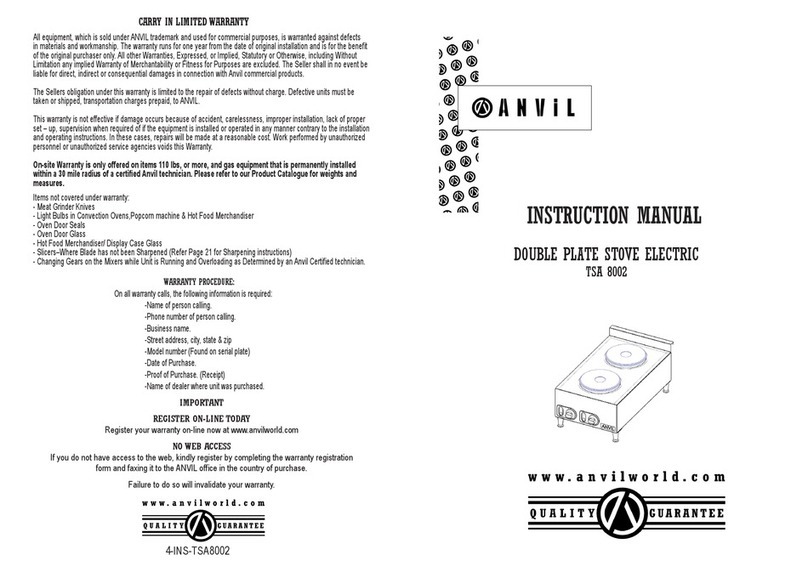
Anvil
Anvil TSA 8002 instruction manual
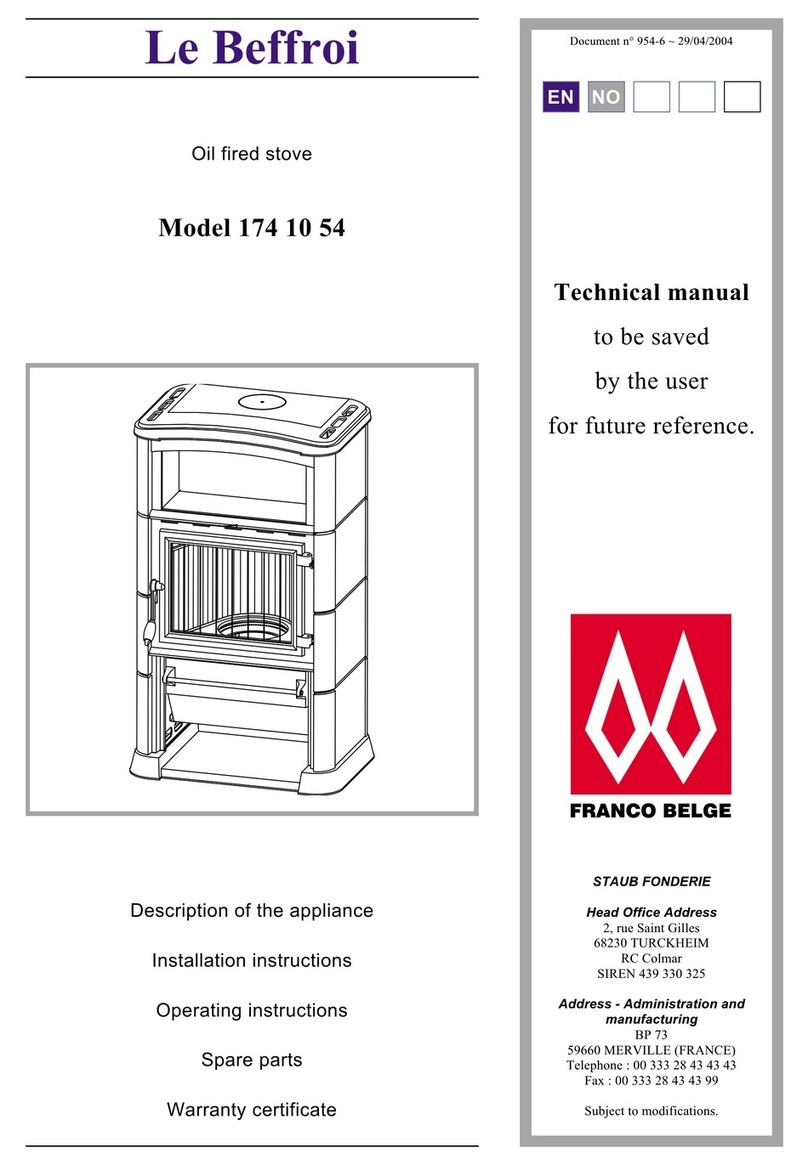
FRANCO BELGE
FRANCO BELGE 174 10 54 Le Beffroi Technical manual
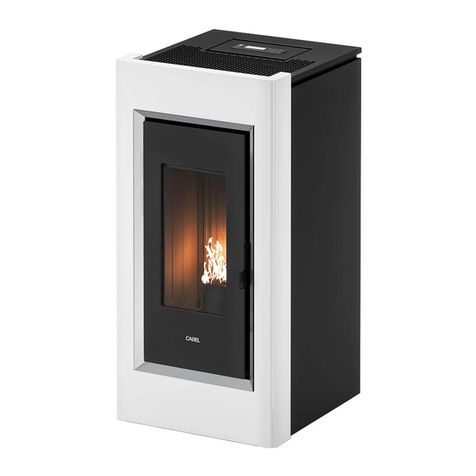
Cadel
Cadel PRINCE 11 Installer manual
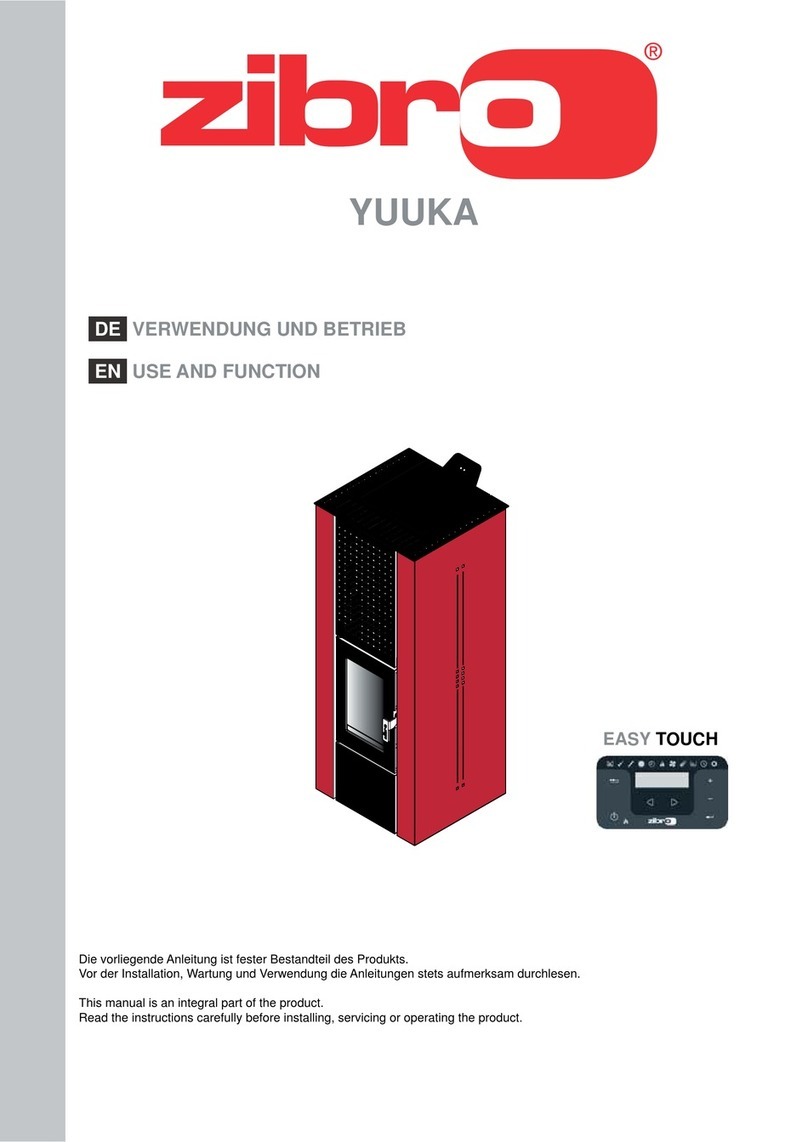
Zibro
Zibro YUUKA USE AND FUNCTION
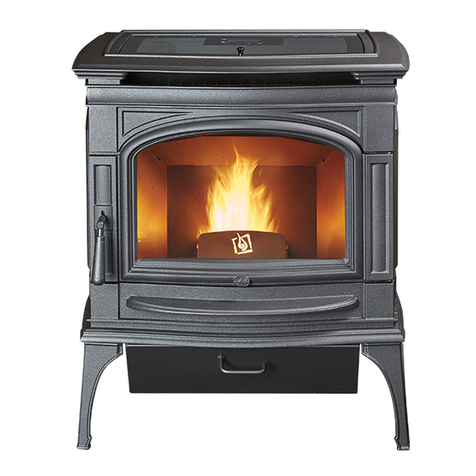
Travis Industries
Travis Industries Deerfield Service & troubleshooting guide

Drija
Drija TURIN 60 user manual
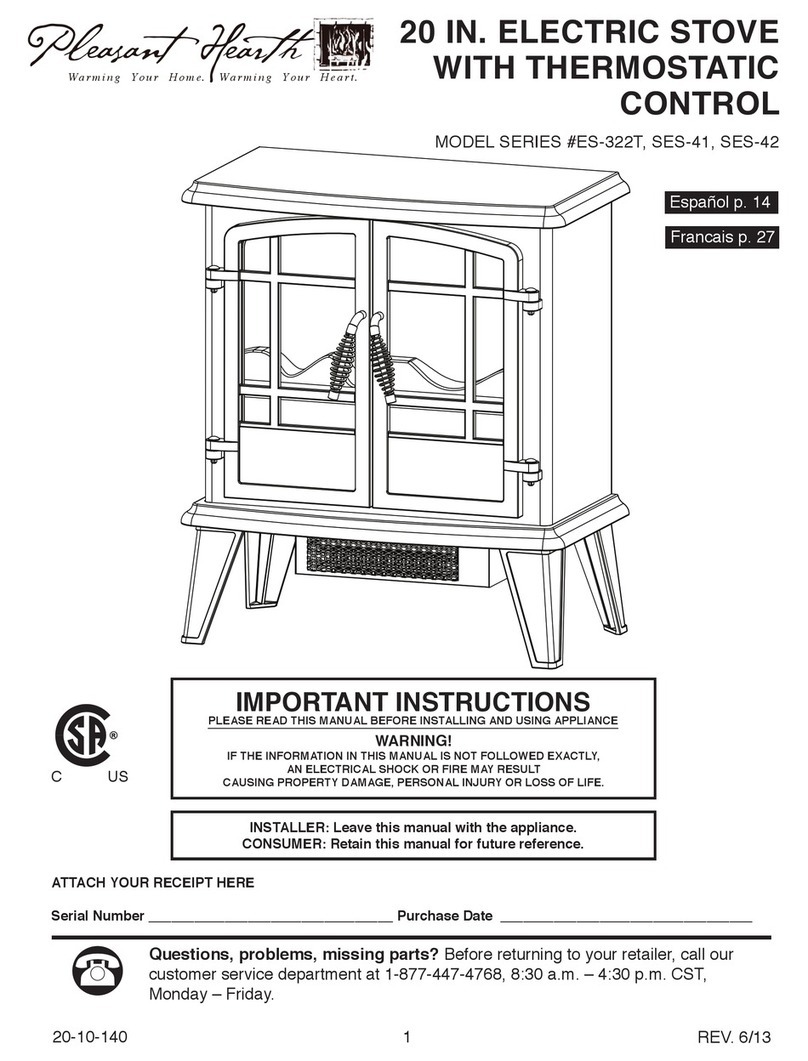
pleasant hearth
pleasant hearth ES-322T Important instructions
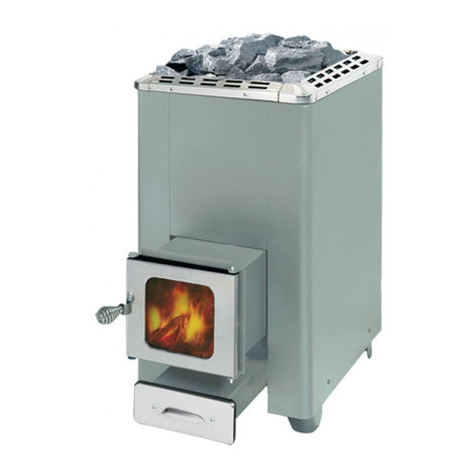
NARVI
NARVI 30 Series Installation, use and service instructions

Diamond
Diamond RF3G/Q User and installation manual

Clarke
Clarke PARLOUR user guide
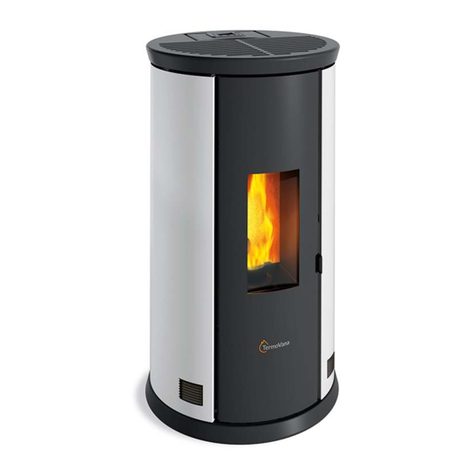
termovana
termovana FANCY 12 GENERAL INFORMATION - WARNINGS - INSTALLATION - MAINTENANCE
